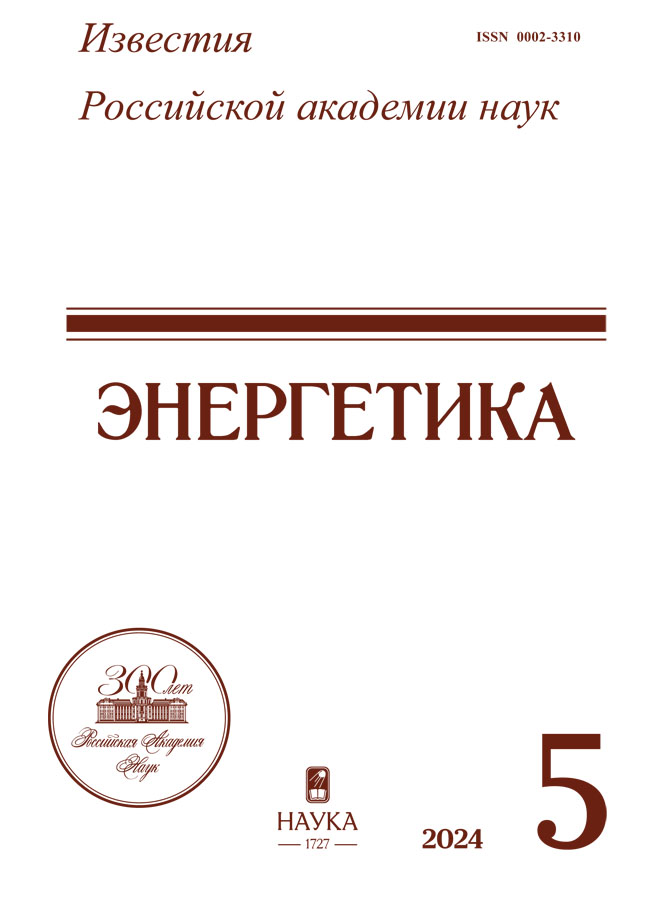Selection оf energy sources for prosumers in the centralized heat supply system using agent technologies
- Autores: Barakhtenko E.A.1, Mayorov G.S.1, Sokolov D.V.1, Tashlykova V.B.1
-
Afiliações:
- Melentiev Energy Systems Institute of Siberian Branch of the Russian Academy of Sciences
- Edição: Nº 5 (2024)
- Páginas: 42-58
- Seção: Articles
- URL: https://jdigitaldiagnostics.com/0002-3310/article/view/660244
- DOI: https://doi.org/10.31857/S0002331024050045
- ID: 660244
Citar
Texto integral
Resumo
In recent years, the energy sector has been widely developing the direction associated with the introduction of distributed energy generation and the emergence of prosumers (PR), including within the heat supply system. Due to the emergence of consumers as participants in energy markets who take an active part in the process of managing their energy supply, there is a need to make decisions on energy supply options in the context of conflicting interests of the parties - the PR and the centralized heat supply system (CHS). The article presents a mathematical formulation of the problem of finding a compromise solution, which includes an PR model, a CHS model and a generalized desirability criterion. A methodology for selecting energy source equipment for PR in the CHS has been developed, taking into account the interests of the CHS and PR and their ability to produce heat energy. A structure of a multi-agent system is proposed and agent behavior algorithms are developed that take into account the complex behavior of the PR and CHS objects. The results of testing the developed methodological and software on a test model of the heat supply system are presented.
Texto integral
Sobre autores
E. Barakhtenko
Melentiev Energy Systems Institute of Siberian Branch of the Russian Academy of Sciences
Email: mayorovgs@isem.irk.ru
Rússia, Irkutsk
G. Mayorov
Melentiev Energy Systems Institute of Siberian Branch of the Russian Academy of Sciences
Autor responsável pela correspondência
Email: mayorovgs@isem.irk.ru
Rússia, Irkutsk
D. Sokolov
Melentiev Energy Systems Institute of Siberian Branch of the Russian Academy of Sciences
Email: mayorovgs@isem.irk.ru
Rússia, Irkutsk
V. Tashlykova
Melentiev Energy Systems Institute of Siberian Branch of the Russian Academy of Sciences
Email: mayorovgs@isem.irk.ru
Rússia, Irkutsk
Bibliografia
- Стенников В.А., Воропай Н.И., Барахтенко Е.А., Соколов Д.В. Цифровизация интегрированных энергетических систем // Энергобезопасность и энергосбережение, 2020. № 4. С. 5–10.
- Стенников В.А., Постников И.В., Пеньковский А.В. Методы и модели оптимального управления теплоснабжающими системами с активными потребителями тепловой энергии // Известия Российской академии наук. Энергетика, 2021. № 3. С. 12–23.
- Воропай Н.И., Паламарчук С.И., Подковальников С.В. Современное состояние и проблемы электроэнергетики России // Проблемы прогнозирования, 2001. № 5. С. 49–69.
- Воропай Н.И. Smart Grid: Мифы, реальность, перспективы // Энергетическая политика, 2010. № 2. С. 9–15.
- Lee M., Han C., Kwon S., Kim Y. Energy and cost savings through heat trading between two massive prosumers using solar and ground energy systems connected to district heating networks // Energy, 2023. V. 284. 129347.
- Pipiciello M., Caldera M., Cozzini M., Ancona M.A., Melino F., Pietra B.D. Experimental characterization of a prototype of bidirectional substation for district heating with thermal prosumers // Energy, 2021. V. 223. 120036.
- Filho W.L., Trevisan L.V., Lange Salvia A., Mazutti J., Dibbern T., Ruiz de Maya S., Bernal E.F., Eustachio J.H.P.P., Sharifi A., Alarcón-del-Amo M.D.C, Kushnir I. Prosumers and sustainable development: An international assessment in the field of renewable energy // Sustainable Futures, 2024. V. 7. 100158.
- Stennikov V., Barakhtenko E., Mayorov G., Sokolov D., Zhou B. Coordinated management of centralized and distributed generation in an integrated energy system using a multi-agent approach // Applied Energy, 2022. V. 309. 118487.
- Khan M.W., Wang J., Xiong L., Ma M. Modelling and optimal management of distributed microgrid using multiagent systems // Sustainable Cities and Society, 2018. V. 41. P. 154–169.
- Kyriakou D.G., Kanellos F.D., Ipsakis D. Multi-agent-based real-time operation of microgrids employing plug-in electric vehicles and building prosumers // Sustainable Energy, Grids and Networks, 2024. V. 37. 101229.
- Городецкий В.И., Карсаев О.В., Самойлов В.В., Серебряков С.В. Прикладные многоагентные системы группового управления // Искусственный интеллект и принятие решений, 2009. № 2. С. 3–24.
- Wooldridge M., Jennings N. Intelligent Agents: Theory and Practice // The Knowledge Engineering Review, 1995. V. 10. № 2. P. 115–152.
- Захахатнов В.Г., Попов В.М., Афонькина В.А. Функция желательности Харрингтона как критерий оптимального выбора зерносушилки // Известия Оренбургского государственного аграрного университета, 2022. № 2(94). С. 110–114.
- Николаев А.Е. Методика оценки состояния научно-технологического потенциала оборонно-промышленного комплекса России с использованием функции желательности Харрингтона // Экономический анализ: теория и практика, 2013. № 30 (333). С. 22–33.
- Беспалов В.И., Котлярова, Е.В. Основные принципы совершенствования методики социо-эколого-экономической оценки состояния окружающей среды территорий промышленных зон крупных городов // Инженерный вестник Дона, 2011. № 4. С. 137–144.
- Меренков А.П., Хасилев В.Я. Теория гидравлических цепей / М.: Наука, 1985. 278 с.
- Antonova V., Grechishkina N., Kuznetsov N. Analysis of the Modeling Results for Passenger Traffic at an Underground Station Using AnyLogic // Journal of Communications Technology and Electronics, 2020. V. 65. P. 712–715.
- Zhang Y., Wang Y., Wu L. Research on Demand-driven Leagile Supply Chain Operation Model: a Simulation Based on AnyLogic in System Engineering // Systems Engineering Procedia, 2012. V. 3. P. 249–258.
Arquivos suplementares

















